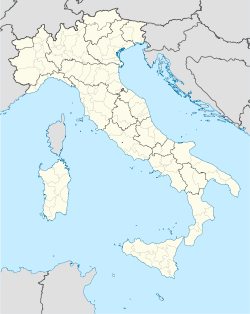- Ostuni
-
Ostuni — Comune — Comune di Ostuni Panorama of Ostuni 
Coat of armsLocation of Ostuni in Italy Coordinates: 40°44′N 17°35′E / 40.733°N 17.583°ECoordinates: 40°44′N 17°35′E / 40.733°N 17.583°E Country Italy Region Puglia Province Brindisi (BR) Frazioni Barbagianni, Boccadoro, Cavallerizza, Cervaloro, Chiobbica, Costa Merlata, Deserto Parco Monsignore, Fantese, Galante, Giovannarocca, Grotta Figazzano, Monticelli, Pascarosa, Pilone, Pinto, Ramunno, Refrigerio, Rosa Marina, Villanova. Government – Mayor Domenico Tanzarella (Democratic Party) Area – Total 223 km2 (86.1 sq mi) Elevation 207 m (679 ft) Population (December 31, 2004)[1] – Total 32,819 – Density 147.2/km2 (381.2/sq mi) Demonym Ostunesi Time zone CET (UTC+1) – Summer (DST) CEST (UTC+2) Postal code 72017 Dialing code 0831 Patron saint Saint Oronzo Saint day August 26 Website Official website Ostuni (Greek: Astynéon) is a city and comune in the province of Brindisi (Puglia, Italy), with a population of about 32,000 located about 8 km from the coast. Its main economic activities include tourism, attracted by its nearby pristine beaches, as well as a vibrant olive and grape agribusiness.
Contents
History
The region around Ostuni has been inhabited since the Stone age. The town is reputed to have been originally established by the Messapii, a pre-classic tribe, and destroyed by Hannibal during the Punic Wars. It was then re-built by the Greeks, the name Ostuni deriving from the Greek Astu néon ("new town").
Sacked after the fall of the Western Roman Empire, in 996 AD the town became part of the Norman County of Lecce. From 1300 to 1463 it was part of the Principality of Taranto and from 1507 (together with Villanova and Grottaglie) passed to Isabella, Duchess of Bari, wife of Gian Galeazzo Sforza, Duke of Milan. Under the influence of Isabella, Ostuni enjoyed a golden-age within the wider panorama of the Italian Renaissance. In this period Isabella gave protection to humanists and people of art and letters, including bishop Giovanni Bovio. Isabella died in 1524 and Ostuni passed as dowry to her daughter Bona Sforza, wife-to-be of Sigismund II Augustus, King of Poland. During Bona Sforza's government, Ostuni continued to enjoyed a liberal and magnanimous regime. In 1539 she had towers built along all the shoreline, as protection against anticipated attacks from the Turks who controlled the Balkans. These towers (still existing, including Pozzella Tower, the Pylon, Villanova and others), were permanently garrisoned and communicated through fire beacons.
Main sights
The so-called "Old Town" is Ostuni's citadel built on top of a hill and still fortified by the ancient walls. Ostuni is regarded as an architectural jewel, and is commonly referred to as "the White Town" ("La Città Bianca", in Italian) for its white walls and its typically white-painted architecture. A monument on its own, the town's largest buildings are the Cathedral and the Bishop's Palace, together with a number of palazzi of local aristocratic families: Aurisicchio, Ayroldi, Bisantizzi, Falghieri, Ghionda, Giovine, Jurleo, Marseglia, Moro, Palmieri, Petrarolo, Siccoda, Urselli, Zaccaria.
In the surrounding countryside there are typical Pugliese "masserie", fortified large estate-farms, one of which, San Domenico, was once held by the Knights of Malta.
Tourism
In the summertime Ostuni is a popular destination for tourists from all over the world. The population rises from about 30,000 inhabitants in wintertime to about 100,000.
References
External links
Puglia · Comuni of the Province of Brindisi Brindisi · Carovigno · Ceglie Messapica · Cellino San Marco · Cisternino · Erchie · Fasano · Francavilla Fontana · Latiano · Mesagne · Oria · Ostuni · San Donaci · San Michele Salentino · San Pancrazio Salentino · San Pietro Vernotico · San Vito dei Normanni · Torchiarolo · Torre Santa Susanna · Villa CastelliCategories:- Cities and towns in Apulia
- Communes of the Province of Brindisi
- Localities of Salento
- Hilltowns in Italy
Wikimedia Foundation. 2010.




